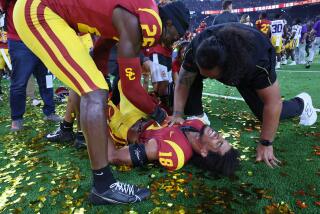Dotting the I at Tailback U. : Garrett Says Crayton Has the Ability of Some of USC’s Great Runners
USC tailback Estrus Crayton comes highly recommended, despite a less than auspicious debut last season.
Mike Garrett, the first of USC’s four Heisman Trophy-winning tailbacks, says that Crayton is potentially the best USC runner since Marcus Allen, who ran for a school-record 2,427 yards during his Heisman season of 1981.
But Garrett doesn’t stop there.
“He could be better than Marcus,” Garrett says. “He has more potential than Marcus.”
Before turning potential into productivity, however, the highly touted Crayton must accomplish a more modest goal of retaining his status as USC’s No. 1 tailback for the next three months.
The last three Trojan tailbacks who opened the season as starters wound up third on the depth chart, or lower, by season’s end.
The most recent was Mazio Royster, who lost his job to Crayton last fall, realized he might never get it back and left school early, giving up his final season of eligibility to make himself available for the NFL draft.
Crayton knows the history.
“The guy that was third always ends up No. 1,” he says, laughing. “I’ve heard that so many times.”
His stated objective is simply to halt the trend, fighting off the challenges of junior Deon Strother, a stronger inside runner, and Dwight McFadden, a second-year freshman who has shown breakaway ability similar to Crayton’s.
For now, at least, you won’t hear wild predictions from Crayton, who nevertheless is quietly confident as he enters his senior year.
“Coach said 1,500 yards, and that’s a pretty nice goal,” Crayton says, revealing the benchmark established for him by Wayne Nunnely, who coaches USC’s running backs. “But I just want to be consistent.”
A 1,500-yard season would be the best by a Pacific 10 Conference player since 1984, when Rueben Mayes of Washington State ran for 1,637 yards.
And 1,500 yards would be almost 1,100 more than Crayton gained last season, when he failed to meet expectations while adjusting to major college football after two record-breaking seasons at Rancho Santiago College in Santa Ana.
Crayton expected to be redshirted last fall after he was unable to attend practice at USC during the spring of 1991 while earning an Associate of Arts degree at Rancho Santiago.
Instead, he was thrown into the tailback rotation.
Crayton didn’t handle it well, dropping the ball four of the first six times he touched it and earning a place in Coach Larry Smith’s doghouse.
“Mentally, I wasn’t ready for college football,” he says.
During USC’s first nine games, he rushed for only 94 yards.
But during a 31-14 loss to Arizona, he finally broke through, coming off the bench in the second quarter and gaining 25 and 23 yards in his first two carries. He ended the game with 185 yards and a touchdown in 27 carries, earning his first start the following week against UCLA.
He ran for 126 yards in 21 carries against the Bruins, the most gained by a runner against the UCLA defense all season.
It was too late to salvage a 3-8 season, their worst since 1957, but the Trojans seemed to have found a game-breaking runner.
Hopes were raised for ’92.
“I was talking to a guy (recently) and he said, ‘You did this, you did that,’ ” Crayton says. “To me, I haven’t done anything.
“I know I can do more if I’m given the opportunity.”
He should count on it.
“I would like to think we would get the ball into his hands anywhere from 15 to 20 to 25 times a game,” Nunnely says.
Smith is looking for more big plays from his offense this season, and Crayton gives him a back who is capable of providing some.
“When he comes at you, he gives you a lot of movement,” Garrett says. “He’s not running at you in a straight line; he’s giving you head and shoulder movement. The guys who have that kind of ability can break big gains. Go back to Jim Brown, Gale Sayers, O.J. Simpson, Walter Payton--all the great running backs could do that.”
Crayton made big plays with regularity at Rancho Santiago.
He never would have gone there, however--and might never have been a college running back--had he scored a NCAA-mandated minimum on the Scholastic Aptitude Test during his senior year at Santa Ana High.
A part-time running back and an All-Southern Section defensive back at Santa Ana, he was ready to sign with UCLA until his low SAT score derailed his plans.
At Rancho Santiago, Coach Dave Ogas built an offense around Crayton after watching him excel during an intrasquad scrimmage.
“I was driving home afterward with my son, Mike, and he said, ‘You know what, Dad, nobody tackled Estrus today,’ ” Ogas said. “I said, ‘Oh, come on.’ But I went back and checked the films.
“They pushed him out of bounds, and they mauled him out of bounds, but they never tackled him. He must have carried the ball 25 or 30 times during a 60-play scrimmage, and they never once tackled him.
“We knew from that point on that he was going to be special.”
He was a two-time junior college All-American, accounting for 4,062 all-purpose yards, 53 short of a national record.
He ran for 2,452 yards, breaking 11 conference records.
He scored 42 touchdowns.
At least one rival coach called him the state’s best junior college running back since O.J. Simpson.
Ogas called him a coach’s dream.
“His sophomore year, he was a marked man and he took some pretty physical beatings,” Ogas says. “But not one time did he ever try to miss a practice. I had to almost physically keep him out of a practice drill one day when he had a double hip-pointer. That’s the kind of kid he was.
“In his two years here, he never missed a practice, never missed a meeting, never was late to a meeting, never was late to a practice. Those little things are the things that really set him apart.”
UCLA took another run at him. But this time, they told him, a couple of his class credits were not transferable. He wouldn’t be admitted. He had already ruled out Arizona State and California, the other schools he visited while at Rancho Santiago, because he feared coaching changes were imminent at both schools.
That left USC.
“I can’t say I was really happy (about UCLA’s stance), but it took a lot of pressure off of me, as far as making a choice,” he says.
Crayton, though, blamed only himself for his inability to hang onto the ball.
“I got my shot,” he told Ogas. “The coaches didn’t fumble the ball for me. I fumbled the ball.”
Crayton’s late-season surge restored his confidence, making him believe that he is capable of running for 100 yards every week.
“Definitely,” he says. “That’s not really a lot of yards. Any decent back in the country, if they’re given the opportunity to carry the ball 20 to 25 times a game, they’re going to get 100 yards. You make two or three big runs, you’ve got 100 yards right there. One hundred yards is really nothing.”
It’s more than he had during the first 2 1/2 months of last season. But that’s in the past.
“He’s an altogether different back--he’s more confident--and that will prove out though out through the year,” Garrett says.
Says Crayton: “Coach Nunnely told me that last season was kind of like my spring practice.”
And if Garrett is correct, a brilliant fall awaits.
More to Read
Go beyond the scoreboard
Get the latest on L.A.'s teams in the daily Sports Report newsletter.
You may occasionally receive promotional content from the Los Angeles Times.






